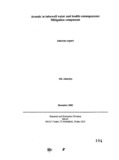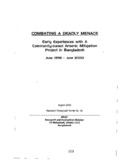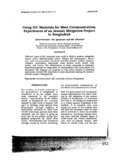Browsing by Subject "Arsenic--Environmental aspects"
Now showing items 1-12 of 12
-
An analytical assessment of GPL kit for field level detection of arsenic in water
(BRAC Research and Evaluation Division (RED), 1999-07)An attempt was taken to evaluate the suitability of GPL kit for field level detection of arsenic in water. The sources of variation in results of tests for arsenic determined by GPL kit seemed to be use of different sets ... -
Arsenic in tubewell water and health consequences: mitigation component
(BRAC Research and Evaluation Division (RED), 2003-12) -
Arsenic testing of newly installed tubewells and quality control
(BRAC Research and Evaluation Division (RED), 1999-04)The presence of arsenic in groundwater in Bangladesh has aroused widespread concern. It is estimated that over half of the Bangladesh population are at risk of arsenic poising. The source of arsenic in drinking water is ... -
Awareness and choice of options of Arsenic-free drinking water
(BRAC Research and Evaluation Division (RED), 2000)The discovery of arsenic contamination in tubewell water has created concern for its potential health effects. BRAC initiated an arsenic mitigation project in two upazilas in 1999. The project included promotion of ... -
BRAC/DPHE/UNICEF collaboration on community-based Arsenic response
(BRAC Research and Evaluation Division (RED), 1999)The severity of the problem of arsenic in ground water in Bangladesh is now well recognized. 97% of the population relics on ground water for drinking and cooking purposes and it is estimated that half of the country may ... -
Combating a deadly menace: early experiences with a community-based arsenic mitigation project in Bangladesh
(BRAC Research and Evaluation Division (RED), 2000-08)Bangladesh is facing the problem of arsenic poisoning in drinking water. Around 27% of the tubewells, which supply drinking water to most of the population, have arsenic concentrations above the government of Bangladesh ... -
Effectiveness of field methods for detecting Arsenic between 0 and 100 ppb in Bangladesh ground water
(BRAC Research and Evaluation Division (RED), 1999-11) -
Fighting arsenic at the grassroots: experience of the community awareness initiative of BRAC in Bangladesh
(BRAC Research and Evaluation Division (RED), 2001)The study evaluates the arsentc mitigation project of BRAC in ra1smg the awareness of arsenic poisoning in the rural communities in Bangladesh. Data came from the selected villages in the southwestern Bangladesh where ... -
Interim report community based arsenic mitigation program: successes and constraints June - October 1999
(BRAC Research and Evaluation Division (RED), 1999)The severity of the problem of arsenic in ground water in Bangladesh is now well recognized. 97% of the population relies on ground water for drinking and cooking purposes and it is estimated that one third of the country ... -
Occurrence, distribution and time-trend of arsenic in ground water of Jhikorgachha, Jessore, Bangladesh
(BRAC Research and Evaluation Division (RED), 2003-09)In order to assess the arsenic concentration change over time, water from a total of 246 tubewells Jhikargachha upazila of Jessore district were tested using atomic absorption spectrophotometer in two different periods ... -
Sustainable community- based safe water options to mitigate the Bangladesh arsenic catastrophe - an experience from two upazilas
(BRAC Research and Evaluation Division (RED), 2003-05)Sustainable community-based safe water options have been successfully operating in two upazilas involving 531 villages and encompassing a population of 497,488. Testing of tubewells for arsenic was carried out on a census ... -
Using IEC materials for mass communication: experiences of an Arsenic mitigation project in Bangladesh
(BRAC Research and Evaluation Division (RED), 2003)Different types of lEC materials were used in BRAe's arsenic mitigation project (June 1999-December 2001). Printed lEC (Information. education. and communication) materials included posters. leaflets. stickers. booklets. ...












